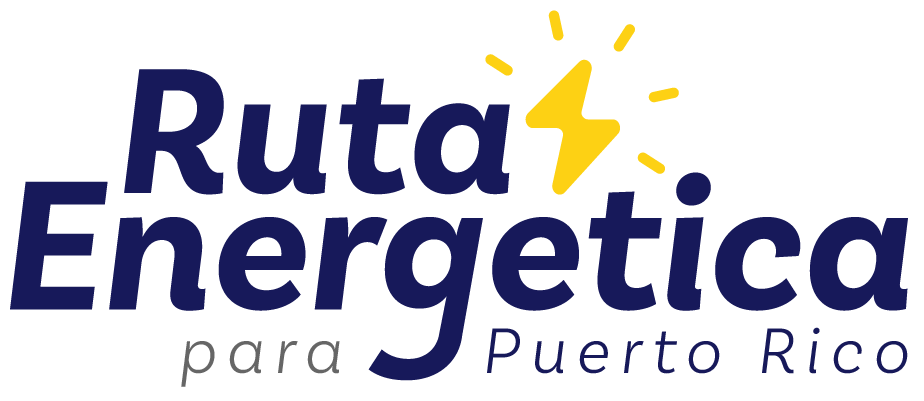Building a Modern Energy Supply and Shutting Down Outdated Power Plants
This page provides information about the current generation system and planned additions and shutdowns consistent with the Puerto Rico Energy Public Policy Act (Act 17-2019 & Act 1-2025).
Current System
This section presents the current electric generation system in terms of capacity of existing generation sources and the net electricity generated by those sources.
Total System Capacity
Capacity, typically reported in megawatts (MW), is the maximum output the generating equipment can supply to the system. Nameplate capacity reflects the total installed capacity, while available capacity reflects the maximum expected output that generating units can supply to the system after considering scheduled or unscheduled outages. The figures below show nameplate and available capacity in Puerto Rico as of December 2024.
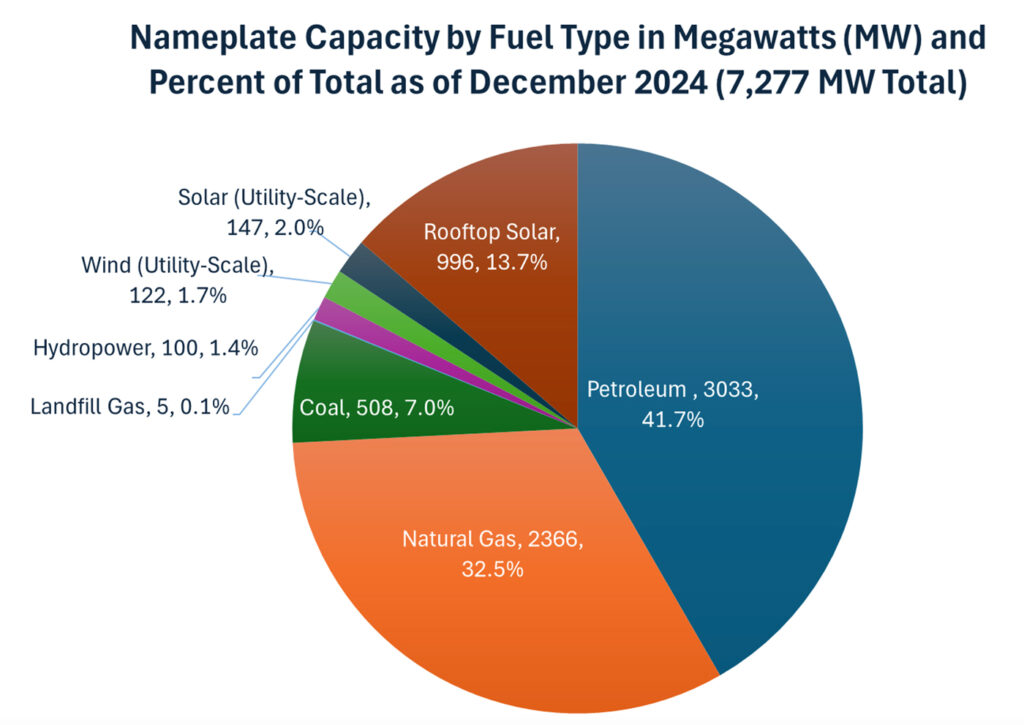
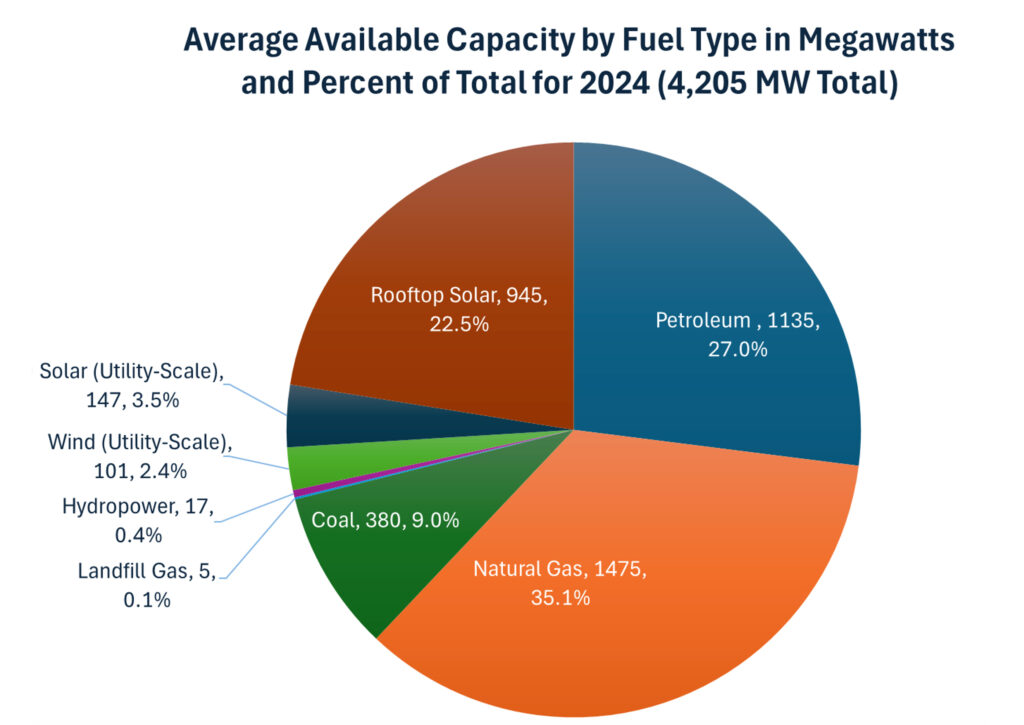
Source: LUMA
Rooftop Solar Capacity
Total installed capacity of distributed solar photovoltaic—rooftop solar—grew from 228 MW in June 2021 to 1,230 MW in June 2025, an increase of more than 400% in four years, as shown in the figure below. Over this timeframe, a small amount of distributed wind generation capacity was reported until August 2023 from which point it appears not to be available.
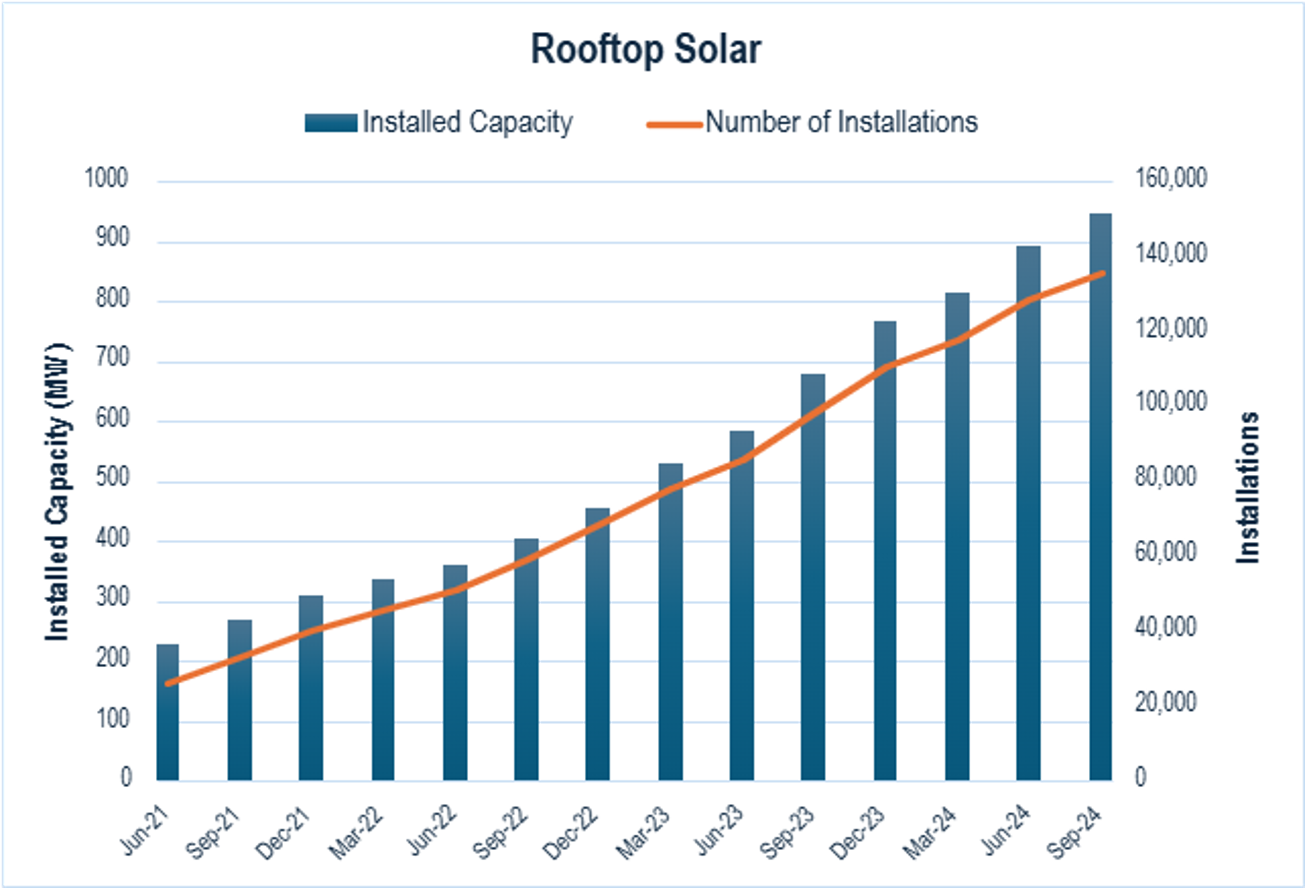
Source: LUMA Quarterly Report, Resumen Metricas Master_July2025, from PREB Docket NEPR-MI-2019-0007
Distributed Battery Storage Capacity
Many customers who install rooftop solar systems also opt for battery storage. Rooftop solar generates renewable energy during daylight hours, while battery storage enables the use of this energy at night and during power outages. Between June 2021 and June 2025, installed distributed battery storage capacity grew from about 370,000 kWh to nearly 2.5 million kWh. Battery storage capacity is typically shown in kWh, representing the total amount of energy it can store. For example, a 5-kWh battery can provide enough energy to power devices totaling 5 kW for approximately one hour, or devices totaling 1 kW for approximately five hours. This means a homeowner can choose to conserve energy and extend the battery’s runtime, or use more power for a shorter period.
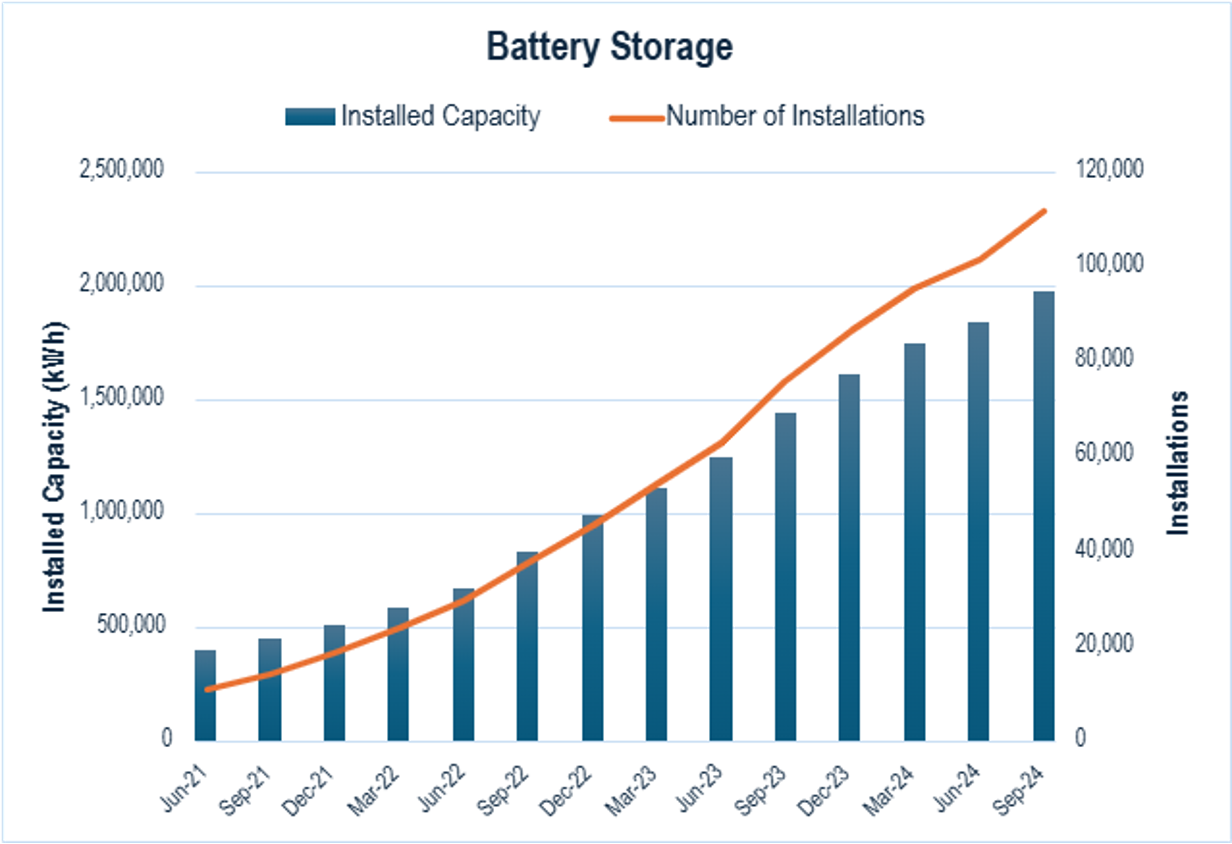
Source: LUMA Quarterly Report, Resumen Metricas Master_July2025, from PREB Docket NEPR-MI-2019-0007
Total Generation
Generation, typically reported in megawatt-hours (MWh) or gigawatt hours (GWh), is the amount of electricity produced over a period of time. The chart below shows electricity generation for January through December 2024 by resource type.
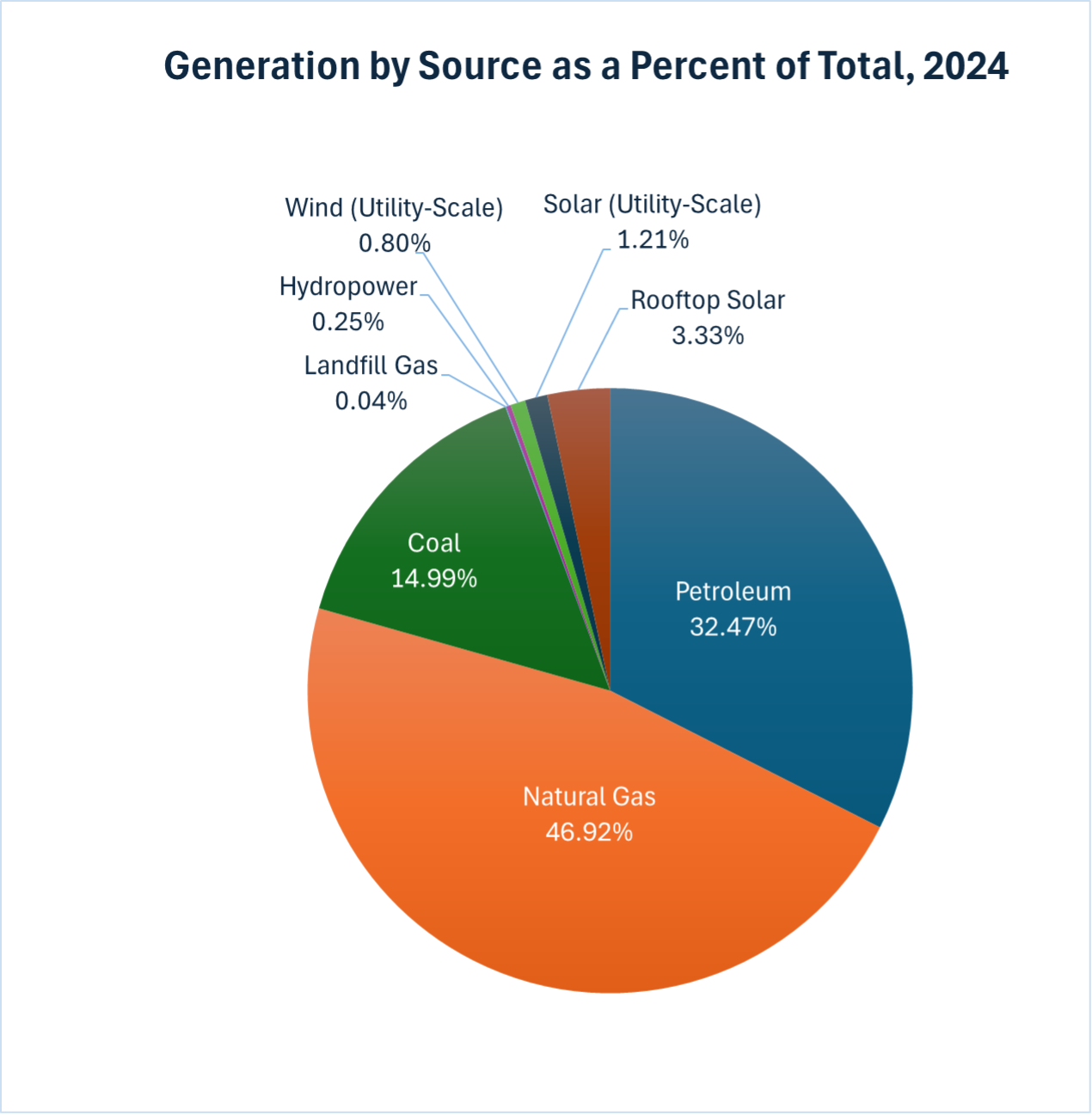
Source: LUMA
Rooftop Solar Generation
The chart above includes the amount of electricity exported to the grid from systems participating in LUMA’s net metering program. This value does not include electricity generated from rooftop solar systems and consumed by customers on site. Comprehensive rooftop solar generation data (including both electricity exported and self-consumed) can be accurately collected by the utility through the use of advanced metering infrastructure, as stated in the Grid Modernization section of this site, LUMA is planning to replace all existing meters with advanced technology over the next three years.
Resources
Read more about the status of Puerto Rico’s current electric system on these websites:
- LUMA’s System Overview dashboard includes information about energy demand, reserves, and supply with filters available by geography base, peaking, and renewables.
- PREPA’s Our Operation dashboard includes information about energy by fuel, total generation, generation and frequency, and type of generation across wind, solar, cogeneration, and hydroelectric.
- Genera PR’s Generation Details webpage includes real-time data about total system generation, available capacity, energy demand forecast, rotating reserve, and operational reserve.
Future System
Several initiatives are underway to add generation capacity to the system in order to shut down outdated and inefficient power plants. This section summarizes those projects that are actively underway. Additional additions and retirements will be defined in the integrated resource plan currently under development by LUMA, due to PREB on May 16, 2025.
Planned Generation Additions
Renewable Energy and Storage Contracts
Since 2021, PREPA and PREB have conducted a competitive procurement process for third-party owned renewable energy and storage systems, often referred to as the “tranches,” which involved a series of solicitations to secure significant amounts of new renewable energy capacity and associated storage. To date, PREPA has signed contracts with successful bidders from Tranches 1 and 2 who are in the process of developing their renewable energy and storage projects. The resulting capacity and contractual in-service dates are as follows:
- Tranche 0: 200 MW of solar PV capacity.
- Tranche 1: 578.8 MW of solar PV capacity and 350 MW of battery storage. In service dates range between 2025 and 2026.
- Tranche 2: 66 MW of solar PV capacity and 60 MW of battery storage. In service dates in 2026.
Tranche 3 was cancelled, and Tranche 4 selections are underway.
Genera PR’s Battery Energy Storage Systems (BESS)
The adoption of battery energy storage systems (BESS) in Puerto Rico represents a major step toward improving grid stability and responsiveness. BESS will facilitate the integration of renewable energy sources, which will in turn reduce reliance on expensive, inefficient energy sources. In the long term, this could potentially generate significant savings and reduce operating costs.
With storage systems installed in six locations—Vega Baja, Cambalache, Costa Sur, San Juan, Palo Seco, Yabucoa, and Aguirre—BESS will add 430 MW of storage (equivalent to 1,720 MWh of energy) capable of providing four hours of backup power. BESS will help stabilize the grid by reducing load shifting (estimated 90% reduction) and better ensure the grid can react quickly to unexpected events or power demands by providing an ultra-fast response rotating reserve for critical situations.
Genera PR has announced plans to acquire BESS from Tesla Puerto Rico LLC; however, the final contract and installation phase are subject to approval and permitting. Read more on Genera PR’s website.
LUMA’s Accelerated Storage Addition Program (ASAP)
LUMA is working with existing independent power producers to integrate industrial-scale BESS on-site as part of the Accelerated Storage Addition Program. The Accelerated Storage Addition Program will provide a standard offer to add BESS capacity at existing qualified power generating facilities. Installed BESS would be dispatched by LUMA to provide time shift services, voltage and frequency support, and other ancillary services, thereby improving energy system reliability. The first phase is expected to significantly reduce load sheds and save customers approximately $100M in fuel costs annually through the addition of 180 MW of industrial battery storage. Read more in LUMA’s Oct. 2024 article about the Lack of Reliable Power Supply … Ongoing Threat to Service Reliability.
New LNG-to-Hydrogen Facility
On Dec. 22, 2024, Puerto Rico’s Governor Pedro Pierluisi announced the selection of Energiza to build and operate a new 478-MW power plant in San Juan. The plant will initially use liquefied natural gas (LNG) but is designed to eventually run on hydrogen, making it cleaner than oil-fired plants. This is a significant development, as it is the first large-scale privately built power plant in over 20 years. The project, a 30-year contract with two potential 10-year extensions, is expected to begin operations by June 30, 2028, and will provide energy at a competitive cost of 11.6 cents per MW. Energiza, a consortium including Puerto Rican companies and Mitsubishi and NAES, was chosen through a competitive bidding process compliant with Puerto Rican law.
Planned Generation Shutdowns
Act 1-2025 mandates the elimination of the use of coal as an energy source by December 31, 2032. Act 1 allows the capacity of coal-based generation to be replaced by an equivalent, non-intermittent sources that are compliant with Act 17-2019.
